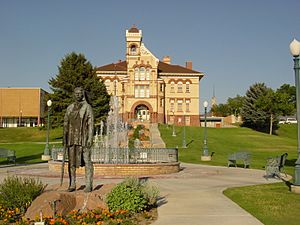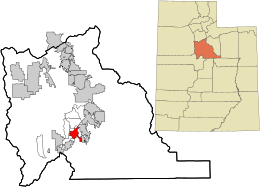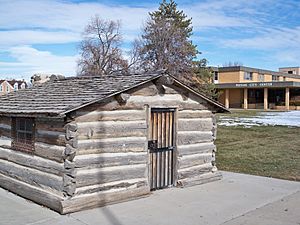Payson, Utah facts for kids
Quick facts for kids
Payson, Utah
|
|
|---|---|
|
City
|
|

Peteetneet Museum in Payson
|
|

Location in Utah County and the state of Utah
|
|
| Country | United States |
| State | Utah |
| County | Utah |
| Founded | October 20, 1850 |
| Incorporated | January 21, 1853 |
| Named for | Payson, Adams County, IL |
| Area | |
| • Total | 13.05 sq mi (33.81 km2) |
| • Land | 13.04 sq mi (33.78 km2) |
| • Water | 0.01 sq mi (0.02 km2) |
| Elevation | 4,669 ft (1,423 m) |
| Population
(2020)
|
|
| • Total | 21,101 |
| • Density | 1,618.17/sq mi (624.66/km2) |
| Time zone | UTC-7 (Mountain) |
| • Summer (DST) | UTC-6 (Mountain) |
| ZIP code |
84651
|
| Area code(s) | 385, 801 |
| FIPS code | 49-58730 |
| GNIS feature ID | 2411391 |
| Website | http://www.paysonutah.org |
Payson is a city located in Utah County, Utah, in the United States. It is part of the larger Provo–Orem metropolitan area. In 2020, the city had a population of 21,101 people.
Contents
History of Payson
Early Settlers and Naming
The first settlers of what is now Payson were pioneers from the Church of Jesus Christ of Latter-day Saints. They were led by James Edward Pace Jr. On October 20, 1850, Pace and his family, along with the families of John Courtland Searle and Andrew Jackson Stewart, arrived. There were 16 settlers in total, and they settled near Peteetneet Creek.
The settlement was first called Peteetneet Creek. This name came from Chief Peteetneet, a leader of the Timpanogos Indigenous Americans. His village was located about a mile northwest of Payson's current city center. The name Peteetneet comes from the Timpanogos dialect of the Southern Paiute language, meaning "our water place." Chief Peteetneet's village could hold over 200 people. It was a base for hunting and gathering trips into the mountains.
In March 1851, Brigham Young, who was the Territorial Governor, officially named the settlement Payson. He named it after Payson, Illinois, a small town where his family had found help in 1839.
Becoming a City
In January 1853, Brigham Young proposed a law to make Payson an official city. The law passed on January 21, 1853. This made Payson an incorporated city. Its territory stretched two miles on each side of Peteetneet Creek, from Utah Lake to the mountains.
On April 12, 1853, Payson held its first city election. Voters chose David Crockett as the town's first mayor. He served as mayor for three terms and as an alderman until 1860.
Growth and Development
In 1872, the Payson Tabernacle of the Church of Jesus Christ of Latter-day Saints was dedicated. This was an important religious building for the community.
In 1873, Payson established a high school. This was the first high school in Utah located south of Salt Lake City. It closed a few years later when Brigham Young Academy opened in Provo. An opera house was built in Payson in 1883, showing the town's growing culture.
The Sugar Industry
When the Strawberry Valley Reclamation Project was finished in 1912, the Utah-Idaho Sugar Company decided to build a sugar beet processing factory in Payson. The factory opened in October 1913. By 1915, it was very busy, processing thousands of tons of sugar beets into sugar.
However, a tiny insect called the beet leafhopper caused problems. It carried a disease that damaged sugar beet crops. Farmers in Payson and other areas saw their crops fail. Because of this, the Utah-Idaho Sugar Company closed its Payson factory in 1924. The factory was taken apart in 1940, leaving only the sugar warehouse. Today, the old sugar factory property is used for fertilizer storage and distribution.
Population Changes
| Historical population | |||
|---|---|---|---|
| Census | Pop. | %± | |
| 1860 | 830 | — | |
| 1870 | 1,436 | 73.0% | |
| 1880 | 1,788 | 24.5% | |
| 1890 | 2,135 | 19.4% | |
| 1900 | 2,636 | 23.5% | |
| 1910 | 2,397 | −9.1% | |
| 1920 | 3,031 | 26.4% | |
| 1930 | 3,045 | 0.5% | |
| 1940 | 3,591 | 17.9% | |
| 1950 | 3,998 | 11.3% | |
| 1960 | 4,237 | 6.0% | |
| 1970 | 4,501 | 6.2% | |
| 1980 | 8,246 | 83.2% | |
| 1990 | 9,510 | 15.3% | |
| 2000 | 12,716 | 33.7% | |
| 2010 | 18,294 | 43.9% | |
| 2020 | 21,101 | 15.3% | |
| U.S. Decennial Census | |||
In 2000, Payson had 12,716 people living in 3,654 households. About 51.8% of households had children under 18. The average household had about 3.47 people.
The population of Payson has grown a lot. Between 1990 and 2010, the population doubled from 8,700 to 18,294. By 2020, it had grown to over 21,000 residents.
Culture and Fun in Payson
Payson is a lively city with many fun events and interesting places.
Festivals and Events
- Scottish Heritage Festival: Held every July, this festival celebrates Scottish culture.
- Salmon Supper: An annual event held in August.
- Onion Days Festival: This popular festival takes place every Labor Day weekend.
- Band Concerts: The city has held band concerts in Memorial Park since the 1950s.
Payson in Movies
Payson has been a filming location for several movies:
- The 1984 hit movie Footloose was filmed in Payson, including scenes at Payson High School.
- The 1985 thriller Warning Sign also used Payson as a location.
- The children's movie Banjo the Woodpile Cat (1979) was set in Payson.
- The Disney Channel movie Hatching Pete filmed many scenes in Payson.
Historical Sites
- Peteetneet Museum and Cultural Arts Center: This building was originally the first school in Payson. It is named after Chief Peteetneet. It's known for its history, beauty, and even for sledding!
- Historic Main Street: Payson celebrates its history with monuments and markers on Main Street, pointing out houses and sites that are over a hundred years old.
Famous People from Payson
Payson is the birthplace of singer-songwriter Jewel. It is also the hometown of Disney animator and film producer Don Bluth.
Schools in Payson
Payson is part of the Nebo School District. The public schools in Payson include:
- Payson High School
- Payson Junior High School
- Mt. Nebo Middle School
- Barnett Elementary
- Parkview Elementary
- Springlake Elementary
- Taylor Elementary
- Wilson Elementary
Payson High School is one of the few schools in the USA that has its own Bagpipe Band!
Annual Events
Payson hosts the Onion Days and Salmon Supper events every August. It also has an annual Scottish Festival.
The Story of Payson Onion Days
At the start of the 1900s, many farmers in Payson faced tough times. Charlie Gale was one farmer looking for a good crop. His son, Elmer Gale, suggested growing onions. Elmer bought crops from farmers and sold them to stores, and he knew onions were in demand.
Elmer's idea worked! Onions became a very profitable crop for Charlie Gale, who became one of Payson's biggest onion growers. Other farmers soon started growing onions too. By 1929, Payson was famous for its onion production.
Many towns across the country were starting harvest festivals. Payson decided to create its own celebration to honor its farming history and its success with onions. This led to the first Onion Harvest and Homecoming festival.
To honor Elmer Gale's important role, the first Onion Days festival was planned for his birthday, September 2, 1929. It was later moved to September 12-14, 1929. This celebration became an annual event, showing Payson's strong connection to onion farming and its community spirit.
Notable people
- Earl W. Bascom, rodeo pioneer "Father of Modern Rodeo, cowboy artist and sculptor
- Don Bluth, animator and film producer
- Toby Bluth, Disney animator
- William Clayson, Mormon pioneer, LDS hymn writer
- Brandon Flowers, lead singer of The Killers, lived in Payson
- Orson Pratt Huish, LDS hymn writer
- Kaycee Feild, World Rodeo Bareback Champion
- Lewis Feild, World Champion Bareback rider, hall of fame inductee
- Jewel Kilcher, singer-songwriter known as "Jewel", born in Payson
- Jesse Knight, Mormon pioneer, rancher, mining magnate, industrialist
- O. Raymond Knight, rancher, rodeo champion
- Dallin H. Oaks, LDS Apostle, attended elementary school in Payson
- Barret Peery, basketball head coach, Portland State
- Joseph L. Townsend, LDS hymn writer
See also
 In Spanish: Payson (Utah) para niños
In Spanish: Payson (Utah) para niños


